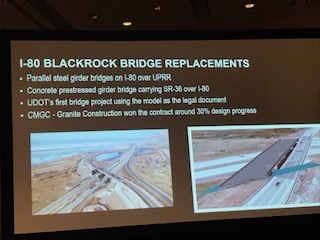A year ago, I had to miss my first Transportation Research Board meeting in over 20 years. Unlike bridge inspectors who do their best to monitor the health of their structures, I kept ignoring the warning signs in my own body, and ended up with a nasty sepsis infection that derailed a good part of 2019 for me personally and professionally.
This year, I was almost ecstatic to be back at TRB. As always, there were too many interesting sessions to choose from. One, on the use of BIM in bridge construction, gave me additional information regarding the story I’d written last year. Connor Christian of HDR noted that a BIM standard being developed by the American Association of State Highway and Transportation Officials in conjunction with 15 states will, in its initial version, apply to design and fabrication or design and construct. The standard will comply with a data standard issued by buildingSMART International.
His colleague Colby Christensen noted that on the I-80 Blackrock Bridges project in Utah, less than half of the information used from paper plan sets were actually needed by the contractor. A BIM document streamlined the information to be shared, and surveyors saved three weeks of work, he said. However, “some subcontractors are never going to use the model,” because they simply don’t need to, he said.

Technology dominated the sessions at the conference, with automated and connected vehicles looming large as a topic. Others included drones. Michael Russo, assistant commissioner at New Jersey Dept. of Transportation, said the agency had established the first-ever DOT peer exchange platform for drones. NJDOT has been using drones to monitor projects, analyze congestion, inspect bridges and dredging conditions and map site conditions. Potential future uses include thermal inspections of concrete bridge decks, analyzing potholes, and even counting bats under bridges, he said.
That same week, back in LA, I had the honor of seeing Cliff Schexnayder, with whom I once trudged through the construction site of the Panama Canal’s third set of locks, and Tom Groark, one of our 2003 newsmakers for his work after 9/11 on saving and restoring PATH trains, at the Low Bidders Dinner. The next night was the Beavers, where I had the fortune of running not only into my 2019 newsmaker Sam Hassoun, but Malcolm Dougherty, former Caltrans director, who is ever so slightly enthusiastic about the future of automated vehicle technology. He greatly informed my upcoming cover story on technology and transportation.

Cliff Schexnayder, a sepsis-free ENR editor, and Tom Groark
It’s great to be back in the saddle again. 2019 couldn’t go by the wayside quickly enough.

Recent Comments
https://syedconsultancy.com/
Congratulations Kyle!
Construction Burnout
Construction burnout
Working 11 days on, 3 days off, 13-15...